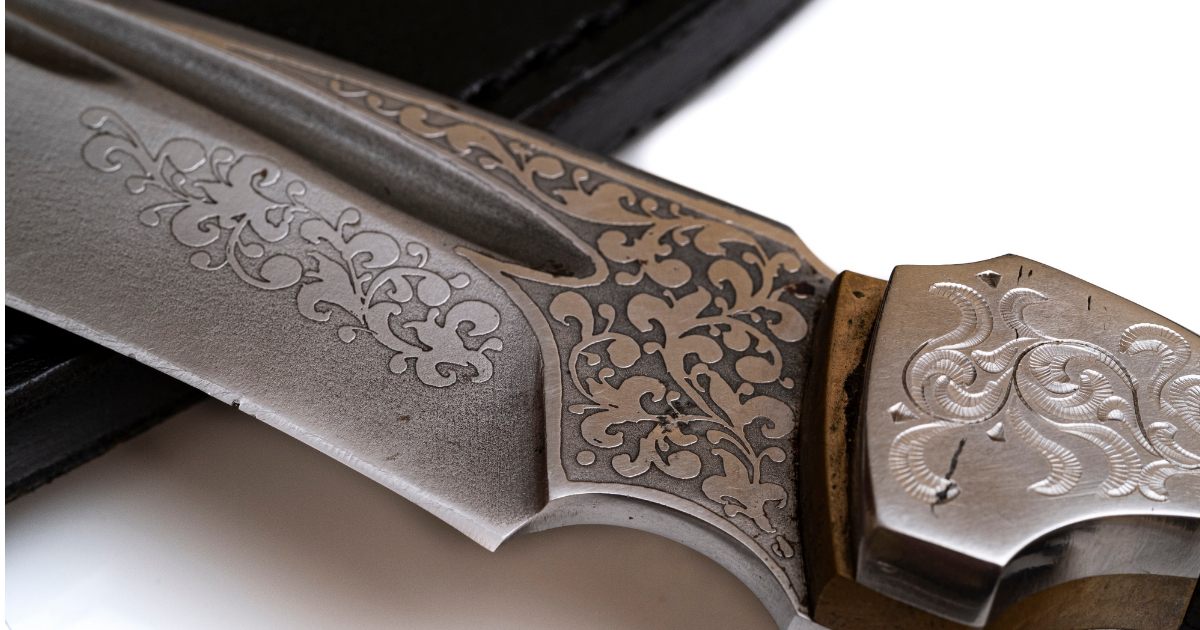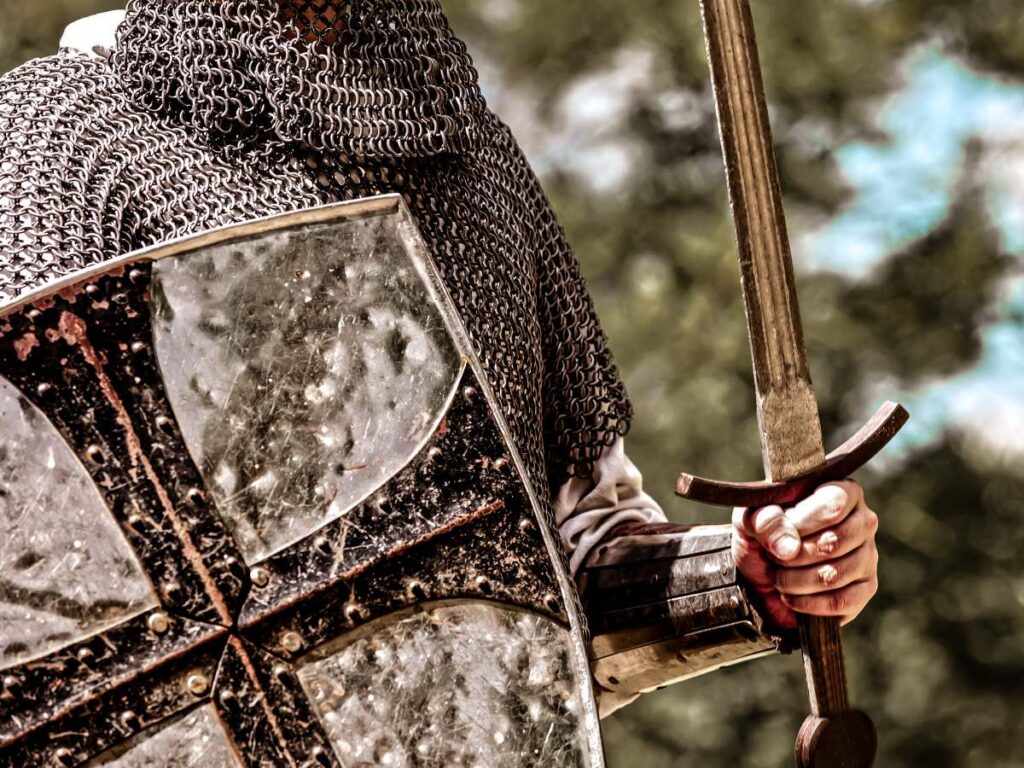Who hasn’t gazed at the stars and wondered about the mysteries they hold? Now imagine that a piece of that celestial wonder lands in your hands, not as a fiery shooting star, but as a dazzling sword. That’s right, friends! We’re about to go through on an epic adventure and explore the rich history of swords made out of meteorites. Hold on tight; this will be one heck of a ride!
Iron of Meteoritic Origin: From Stars to Swords
Imagine a time long ago, when iron was as valuable as gold! People hadn’t even learned how to make steel yet. When they found meteorites, they called it “sky iron” and thought it was a special gift. It was strong and rare, perfect for making awesome weapons. That’s how people started making swords from meteorites!
Making these swords was really tough. They had to heat the meteorite until it was super hot, then pound it into the shape of a sword, and finally let it cool down. It was hard work, but the blacksmiths who made these swords were amazing! They turned pieces of space rock into incredible weapons!
The Science of Meteoritic Iron
To truly understand the magic of meteorite swords, we need to learn about the science behind these celestial gifts. Meteorites are fragments of space rocks or meteors shattered by impacts that survive their fiery journey through Earth’s atmosphere and land on our planet. These fascinating objects offer a glimpse into the formation of our solar system, and some hold the key to crafting extraordinary tools or weapons.
Types of Meteorites
Meteorites come in three main types:
- Iron meteorites: These are almost entirely composed of iron and nickel, making them ideal for forging swords.
- Stony-iron meteorites: These contain a mix of iron-nickel and silicate minerals.
- Stony meteorites: These are mostly made up of silicate minerals and are less suitable for swordmaking.
Why Iron Meteorites?
Iron meteorites are the stars of our show (pun intended!). Their high nickel-iron content provides the strength and durability needed for a functional blade. But there’s more to it than just chemical composition.
Unique Properties
- Nickel Content: The nickel in meteoritic iron not only adds strength but also contributes to the unique properties of the blade.
- Widmanstätten Patterns: When etched with acid, iron meteorites reveal intricate, crisscrossing patterns known as Widmanstätten structures. These patterns proves the meteorite’s extraterrestrial origin and slow cooling process in space, adding a touch of cosmic artistry to the blade.
A Glimpse into the Past
These “gifts from the heavens” aren’t just chunks of metal; they’re time capsules from the early solar system. Studying them helps scientists unlock secrets about the formation of planets and the conditions that existed billions of years ago to the beginning of the iron age. So, when you hold a meteorite sword, you’re not just holding a weapon; you’re holding a piece of history, a piece of the cosmos itself.
The Challenges of Working with Meteoritic Iron
While iron meteorites offered an incredible material for early swordsmiths, working with this “gift from the heavens” was far from easy. It presented unique challenges that required ingenuity and skill to overcome.
Impurities and Inclusions
Unlike processed iron ore, meteoritic iron often contains impurities like nickel and other trace elements. These impurities can make the metal brittle or unpredictable during the forging process. Ancient smiths had to develop techniques to manage these impurities and ensure a strong, reliable blade.
Crystalline Structure
The crystalline structure of meteoritic iron, formed over millions of years of slow cooling in space, can also pose challenges. This structure can make the metal more difficult to shape and can lead to cracking or breaking if not handled carefully.
Heat and Hammering
To forge a sword from meteoritic iron, the smith had to heat the metal to extremely high temperatures and then hammer it into shape. This process required precise control of the heat and careful hammering techniques to avoid damaging the unique properties of the material.
A Testament to Skill
Despite these challenges, ancient blacksmiths mastered the art of working with meteoritic iron. They developed specialized techniques, passed down through generations, to create stunning and effective weapons. The existence of these swords proves the ingenuity and skill of early artisans who turned a piece of the cosmos into a tool of power and beauty.
The Sword of Tutankhamun: A Pharaoh’s Celestial Weapon
When King Tut’s tomb was opened in 1922, people found an amazing treasure: a sword made from a meteorite! This special meteoric iron dagger had a gold handle, a shiny crystal top, and a beautiful cover with pictures of flowers and animals. Scientists proved that the sword was made from a rock that fell from space, which is why it’s called “The Celestial Weapon”.
This sword was more than just a weapon to King Tut. Ancient Egyptians believed that meteorites were gifts from the gods, with magical powers. Having a sword made from a meteorite showed everyone how powerful the king was and that he was protected by the gods.
The sword is also cool because it shows how skilled the Egyptians were at making things. They knew how to use metal to create amazing things, and they believed that objects from space were very important. The Sword of Tutankhamun is like a window into the past, showing us how awesome ancient Egypt was!
Legends from the Land of the Rising Sun (Swords from Japan)
Japan has some amazing legends about swords! In these stories, skilled blacksmiths made special curved swords called katanas, often used by samurai warriors. These swords were not just weapons, but important cultural objects imbued with symbolism and meaning. One of the most famous swords is called “Kusanagi”. Legend says it was made from a meteorite that fell from the sky!
This sword has a great `story. A long time ago, a god named Susanoo found the sword inside a giant snake he had defeated. He gave the sword to the sun goddess Amaterasu as a gift. Because of this, the Kusanagi sword became a symbol of power for the emperors of Japan.
People say that the Kusanagi sword has magical powers because it was made from a meteorite. It represents the strength and bravery of the samurai and is an important part of Japanese history and legends.
Damascus Steel: The Unraveling Mystery

The Middle East holds a fascinating mystery: Damascus steel. These legendary swords are famous for their beautiful, wavy patterns and incredible strength. For centuries, people have been captivated by these blades, wondering how they were made and what gave them such remarkable qualities.
One intriguing theory, explored in the field of meteoritics, suggests that Damascus steel may have been made using metal from meteorites! This could explain their exceptional toughness and those unique patterns. Even though the exact process remains a secret lost to time, the possibility of a celestial connection adds to their allure.
Damascus steel swords were known for being incredibly sharp and strong. They were unlike any other sword in the world, which is why many stories and legends grew up around them. The secrets of their creation may be lost to the sands of time, but planetary science continues to investigate the composition of these blades, searching for clues about their origins.
While we may never fully understand how they were made, Damascus steel swords continue to fascinate us. The idea that they might contain a piece of the stars adds to their mystique and reminds us of the enduring link between human skill and the wonders of the universe.
Meteorite Swords Today
Even today, some skilled people still make swords from meteorites! Swordsmiths like Yoshindo Yoshihara, Paul Chen, and Richard Furrer are keeping this ancient tradition alive. They use the same methods as the blacksmiths of long ago, but they also have new tools and ideas to make their swords even more amazing.
These swords are very special because they’re like holding a piece of outer space in your hand. Each sword is a mix of art and science, combining the beauty of the stars with the skill of the swordsmith.
It’s really good that people are still making swords from meteorites. It shows that we’re still fascinated by space and that we still value the old ways of making things. These modern swordsmiths are helping to keep an awesome tradition alive!
Star Forged Steel
And there you have it, folks! From the ancient sands of Egypt to the modern smithies, the history of swords made from meteorites has been nothing short of spectacular! These star-forged weapons show human ingenuity and our timeless desire to touch the cosmos. After all, who wouldn’t want to hold a piece of the stars in their hands?
FAQs
Q: Can any meteorite be used to forge swords?
A: Not exactly. Only iron meteorites, which contain a high percentage of iron and nickel, are suitable for sword making.
Q: Are meteorite swords superior to regular ones?
A: While they’re undeniably cool, meteorite swords aren’t necessarily better. Including meteorite iron adds a unique aesthetic and historical value but doesn’t inherently improve the sword’s functionality.
Q: How can I identify a meteorite sword?
A: Unless documented, it’s hard to identify a meteorite sword just by looking. Scientific tests can confirm the presence of meteoric iron, which has a unique ratio of iron to nickel and traces of other elements.
References
- Astronomy – A new origin story for King Tut’s meteorite dagger
- Live Science – King Tut’s Dagger Is ‘Out of This World’
Our Locations
Get a Quote Now
